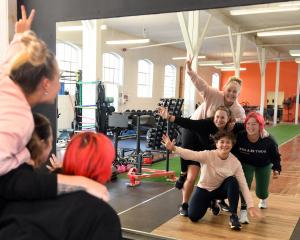Stephanie Desjardins, from Canada, shows how to make pâté au saumon, or salmon pie.
She originally trained as a pastry chef, but since having a family has concentrated on healthy food.
With a friend, she plans to open a market stall selling healthy food.
Pâté au saumon was Stephanie's grandfather's favourite meal.
Her mother would make it using salmon leftovers or even tinned salmon. While béchamel sauce was often served with the pie, she prefers to include it in the filling, she said.
For the pastry
3 cups flour
1 tsp salt or to taste
½ cup (113g) cold butter
½ cup (113g) vegetable shortening
1 egg2 tsp white vinegar
cold water
Salmon filling
2 cups potatoes, peeled and chopped
4 cloves garlic, peeled
¼ cup butter
1 cup chopped leeks
¼ cup cream
450g fresh salmon, skinned and boned
fresh dill, finely chopped, to taste
salt and pepper to taste
Béchamel sauce
2 Tbsp butter
2 Tbsp flour
¾ cup milk
½ cup aged cheddar, grated
egg wash (an egg and a little milk or water whisked together)
To make the pastry
Put the flour and salt into a bowl. Grate the cold butter and shortening into the bowl. Mix with your fingers until the fat is the size of small peas. In a measuring jug, put the lightly whisked egg and the vinegar and make up to ⅔ cup with cold water. Make a well in the centre of the flour and pour in the liquid. Mix lightly until it comes together into a dough. Do not overmix. Pat into a ball, wrap in clingfilm and rest in the fridge for at least four hours or overnight.
You could also make the pastry in a food processor, pulsing the fat into the flour and processing briefly to bring the dough together.
To make the filling
Boil the potatoes with the garlic and, when cooked, mash with butter and salt and pepper to taste.
Meanwhile, heat butter in a pan and add the chopped leeks. Allow to soften briefly then add the cream and the pieces of salmon. Cover and lower the heat, and simmer until the salmon is cooked and the cream reduced. You want as little liquid as possible in the mix. Season to taste.
Combine the salmon and potato mixtures and add the chopped dill. Cool.
To make the béchamel sauce (white sauce)
Melt butter in a saucepan, then stir in the flour. Whisk to incorporate it. When it is cooked, add the milk slowly, whisking all the time until the mixture is thick and cooked. Stir in the cheese. Cool.
To assemble the pie
Divide the chilled pastry into two. Roll out half thinly until it is a little larger than a 22-23cm pie dish. Place in the dish and leave the excess pastry hanging over the edge. Brush the edge with egg wash.
Spread the salmon, leek and potato mixture into the pie dish. Spread the béchamel over it.
Roll out the remaining pastry thinly, brushing any excess flour off it, and lay it over the filling. Press the edges together, folding and squeezing them with your fingers to make a decorative wavy edge.
Brush the pie with egg wash and cut slits in the top in a decorative pattern to allow steam to escape.
Rest in the fridge for an hour or so for the pastry to relax. Put in an oven preheated to 200degC for 30 minutes, then lower the heat to 175degC for another 10 minutes. Stephanie cooks pies near the bottom of the oven so the base of the pie cooks and browns. If the top starts to get too dark, cover it with paper or foil.
When cooked, leave it 15 minutes or so before serving, either hot or at room temperature.
Tips
• Stephanie says using shortening as well as butter makes the pastry nice and flaky.
• It's important to keep everything cold so the pastry is flaky. You can grate the butter and shortening and put it in the freezer before using.
• Adding vinegar to the pastry helps keep it tender.
• You could of course use bought pastry instead of making your own.
• You can use onion instead of leeks.
• If you use a glass pie dish you can see if the bottom of the pie is cooked.
• It is important that the fillings are cool before adding to the pastry, which needs to be kept as cool as possible if it is to remain flaky.
• Thanks to Afife Harris and Centre City New World.













